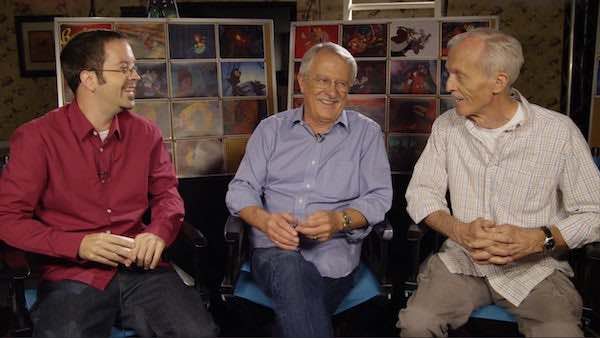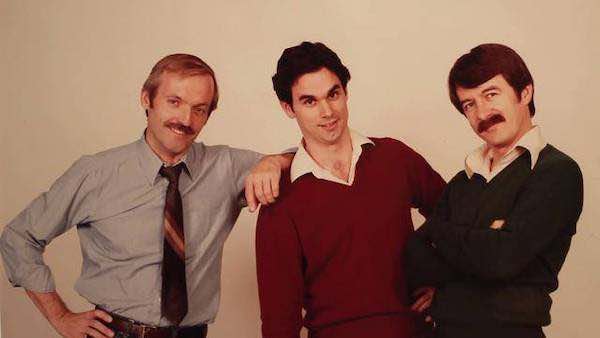Sullivan Bluth had developed a couple of big hits during their 16-year journey. Don Bluth and several Disney animators left to create their animation studio.

After a move to Dublin and a few name changes, the studio closed its doors after its final theatrical release.
Don Bluth and Gary Goldman went on to head up Fox Animation Studios for the giant 20th Century Fox. In 2019, Disney bought 20th Century Fox and rebranded it as 20th Century Studios, the mega movie company.
Sullivan Bluth Studio Photos


Sullivan Bluth Studios Links
Sullivan Bluth Studios Movies List
- The Pebble and the Penguin
- A Troll in Central Park
- Thumbelina
- Rock-a-Doodle
- All Dogs Go to Heaven
- The Land Before Time
- An American Tail
- The Secret of NIMH
Sullivan Bluth Studios History
Animation films have brought us joy since 1906, when J. Stuart Blackton’s “Humorous Phases of Funny Faces” hit screens. One corporation whose brand is synonymous with animation is Disney.
Many are unaware that a lesser-known company forced Mickey and their friends to rethink their approach to animation. That was the Sullivan Bluth Studios, and the chances are, you have watched some of their classics.
Leaving Disney
The Sullivan Bluth Studios were established in 1979 by a talented animator named Don Bluth. He had previously worked at Disney as an animator and contributed to classic films, such as Robin Hood, Sleeping Beauty, and The Sword in the Stone.
During the production of The Fox and the Hound, Bluth and fellow animators Gary Goldman and John Pomeroy decided that enough was enough, and they left Disney to start Don Bluth Productions. They were unhappy with the studios’ bureaucratic structure and mass-production approach to filmmaking, which they felt was impeding the art of animation.
Bluth, Goldman, and Pomeroy recruited a few other disgruntled former colleagues to join them at Don Bluth Productions. They operated out of the luxury office that was Bluth’s garage.
The formative years
After humble beginnings in 1979, Don Bluth Studios went on to create successful independent films, such as Banjo the Woodpile Cat and The Secret of NIMH. During this period they also created the animation for legendary arcade games, Dragon’s Lair and Space Ace. But, as we know, the entertainment industry is cut-throat, and in 1984, the Bluth group went bankrupt.
Don Bluth and his colleagues had built up a reputation for being the best at what they did, and they were gifted a second chance. Morris Sullivan, a successful American businessman, stepped in and partnered with the Bluth group to form Sullivan Bluth Studios. A golden era for the studio.
Sullivan Bluth Studios
In 1985, the company moved to an animation facility in Van Nuys, California. Initially, the studio only produced adverts and short films but had been on the hunt for a suitable feature film. Then, Bluth was approached by Steven Spielberg who shared an idea he had for a feature animation film.
The plot centers around a mouse who emigrates to the United States with his family. It is a familiar narrative for many American families. This film was titled An American Tail. It was directed by Bluth and produced by Spielberg’s production company, Amblin. An American Tail became the highest-grossing animated motion picture upon its initial release in 1986, raking in a staggering $47 million.
Moving to Ireland
During the production of An American Tail, Don Bluth tried to move Sullivan Bluth studios to Ireland. He claimed this was to capitalize on the incentives offered to filmmakers by the Irish government, which included tax breaks, grants, and reduced operating costs.
Bluth managed to set the studio up in Dublin, Ireland. The studio hired many local professionals, as well as retained members from its original team who made the move over from California.
George Lucas and Steven Spielberg
Spielberg’s production company, Amblin had been responsible for the production of the successful film “An American Tail,” however, in Sullivan Bluth studio’s next film, he would take a more hands-on role. Spielberg roped in fellow creative genius George Lucas to work on the next film, The Land Before Time.
This film would go on to be more successful than any of Sullivan Bluth’s previous films, grossing a combined $48 million on the opening weekend. It was only outperformed by Disney’s Oliver and Company, which grossed $53 million. Not a bad performance for a small independent studio facing off against the goliath of the animation world.
All Dogs Go To Heaven
During the production of the studio’s third film, All Dogs Go To Heaven some of its founding members left to return to the United States. Despite having the husky voice of Burt Reynolds, the 1989 film All Dogs Go To Heaven was the studio’s least successful feature film up until this point. Although, it did go on to sell fairly well on VHS.
Bankruptcy Round 2
After the dismal performance of All Dogs Go To Heaven, the studio decided to alter its public relations image to be more suitable for American audiences. To make matters worse, the Irish company Goldcrest, who had bankrolled the previous film was bought out. Based on the financial failures of the previous film, the new owners decided to cut ties with Sullivan Bluth Studios.
In 1992, Sullivan Bluth Studios changed to Don Bluth Entertainment. The studio then released Rock a Doodle. This animation film needed to flourish for the studio to keep going, but it fell well short. Sullivan Bluth Studios lost further financial backing, and they filed for bankruptcy in October of that year.
Merlin Films and Media Assets
Once again, bankruptcy could not defeat Don Bluth and co. They bounced back in November 1992, partnering with Merlin Films and Media Assets, keeping Don Bluth Entertainment alive. Before their second bankruptcy, the studio was busy with the production of three films: Troll in Central Park, Thumbelina, and The Pebble and the Penguin.
Merlin and Media Assets put up $14 million to purchase the three films. None of the films went on to perform well at the box office, and after the dismal results of the Pebble and the Penguin, Sullivan Bluth Studios finally closed its doors in 1995.
After Don Bluth Entertainment had entered into an agreement with Merlin Films and Media Assets, Fox Television approached its remaining founders, Bluth and Goldman. The media giant wanted Goldman and Bluth to set up an animation division within the company.
The two would need to move to Phoenix, Arizona to make this happen, something they did not desire. Eventually, in 1995, Don Bluth and Gary Goldman crossed the Atlantic to set up Fox Animation Studios. They would go on to co-direct Fox’s first-ever animation feature film, Anastasia.
Sullivan Bluth studios have enjoyed an animated history and have often pivoted to survive. With the advent of cheaper production and distribution methods, now is the perfect time to see the combination of Bluth and Goldman’s animative genius playing on our own Netflix and YouTube screens.
Also, check out Warner Animation Group.